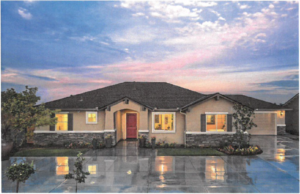Plans for a compact subdivision in south Visalia will move forward after the Visalia City Council voted 3-2 to overturn a previous decision by the city’s Planning Commission that stopped the development.
Housing in Commercial Zone

By overruling the commission, the council agreed to allow San Joaquin Valley Homes to divide 4.8 acres skirting an ongoing commercial development in a mixed commercial use zone into plots for 30 single-family houses. The subdivision will be located a few hundred feet south of the intersection of Caldwell Avenue and West Street, fronting along Kimball Avenue between West and Court Street. The subdivision will be a so-called 5-pack, with six dense clusters of five small homes each served by single entries along Kimball.
Members of the planning commission who voted against the project, along with staff at the Planning Office, felt the project did not meet standards of both the city’s general plan, as well as the intent of the commercial mixed-use land designation.
“It looked more as a stand-alone development, rather than a mixed use,” said City Planner Paul Bernal.
Myriad Ongoing Problems
Also at issue were problems with refuse collection, traffic, parking, noise and congestion. There was also a concern the site could prove inaccessible to emergency services.
“We could get a rig in,” said a city fire official present at the June 16 city council meeting. “It would be less than efficient.”
The area has already seen development decisions by the council that residents in surrounding neighborhoods have found upsetting, and this decision marks the second time this council has overturned a decision by the commission on development at this site. Previously, the council voted to overrule a planning commission decision and allow development of an AM/PM gas station and market at Caldwell and West that will now stand adjacent to the 5-pack homes.
In both instances, development plans met opposition from those who will have to live closest to the outcome of the council’s planning decisions.
“The 5-pack is just a poor excuse for high-density housing,” said Bill Reeser, whose home is located just yards from the future housing development.
AM/PM Situation Made Worse
Allowing the development of the AM/PM, Reeser maintains, has exacerbated a traffic situation on West Street that was already dangerous. The housing development will make matters even more hazardous, he says.
“Somebody is going to be hurt,” Reeser said. “Somebody is going to be killed.”
When the AM/PM was in the developmental stages, the plans faced fierce opposition and stirred complaints from those living in the surrounding upper middle-class neighborhoods about light, noise and increased traffic. Councilman Steve Nelsen said he’s concerned those complaints will be multiplied should housing be constructed immediately adjacent to the source of the irritants.
“This council took a lot of comments about the sound, light and noise. We open ourselves to the people living in the 5-pack complaining, ‘Oh my God! There’s an AM/PM!’” Nelsen said. “At some point, people are going to wake up and say this AM/PM minimart is making too much noise, too much light.”
Help with a Bad Investment
Rick Schuil–partner in the limited liability corporation that owns the land and has for the last decade–said he and his partners have found few developers interested in building on the site. He looked to the council to aid him and his partners out of the situation.
“It has set vacant,” Schuil said. “It has been a difficult project.”
Jim Robinson of San Joaquin Valley Homes told the council the investors have sought an anchor business for the location without success since 1999.
“They either all went bankrupt or moved down the road,” he said. “Neighborhood stores are probably not going to happen in the recent future.”
Mayor Bob Link expressed little confidence a grocery store would be interested in opening at that location.
“They should have a SaveMart or a Winco in the neighborhood, but that’s not going to happen,” he said. “I think the only thing that’s going to happen on that piece of property is housing. The economy has changed radically over the last four or five years.”
Build Standard Housing
 Councilman Greg Collins urged the developers and council to consider building homes much like those that already surround the area under question, rather than high-density 5-packs.
Councilman Greg Collins urged the developers and council to consider building homes much like those that already surround the area under question, rather than high-density 5-packs.
He expressed worry the inherent design problems with 5-packs would accumulate over time, forcing the city to address them again in the future.
“When we’re approving projects, they have to withstand the test of time. When you go back in 15 years, they’ve [other, previously approved developments apart from 5-packs] appreciated in value,” Collins said. “They haven’t become a problem for city services. If you can’t have a positive response to this, you can’t approve a project.”
On the motion of Councilman Brian Poochigian–who very early in the discussions voiced his intent to vote to undermine the Planning Commission’s decision–the council then split 3-2 in OK’ing the project.
Councilmen Nelsen and Collins voted against undermining the commission.
